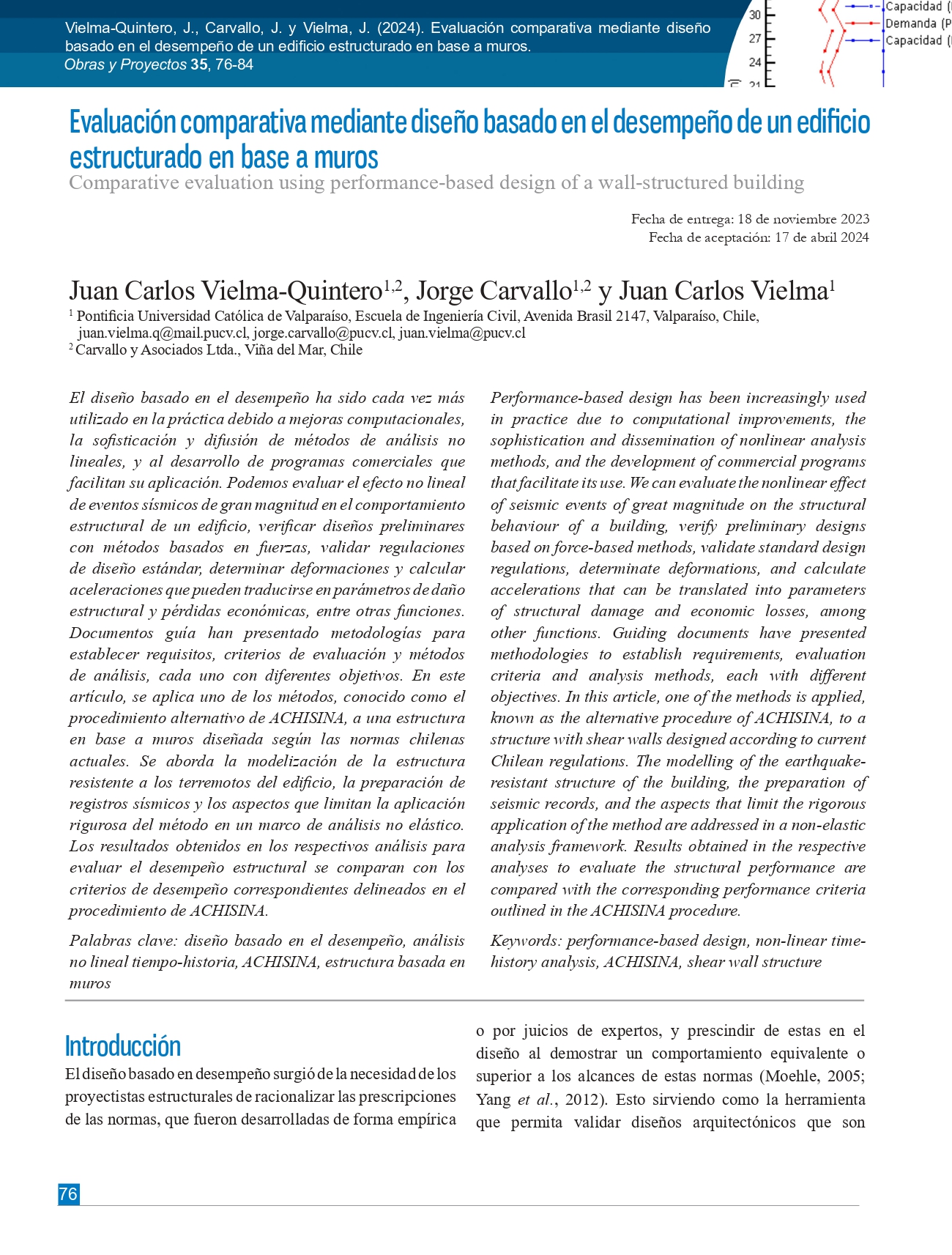Comparative evaluation using performance-based design of a wall-structured building
DOI:
https://doi.org/10.21703/0718-2813.2024.35.2804Keywords:
Performance-based design, Non-linear timehistory analysis, ACHISINA, Shear wall structureAbstract
Performance-based design has been increasingly used in practice due to computational improvements, the sophistication and dissemination of nonlinear analysis methods, and the development of commercial programs that facilitate its use. We can evaluate the nonlinear effect of seismic events of great magnitude on the structural behaviour of a building, verify preliminary designs based on force-based methods, validate standard design regulations, determinate deformations, and calculate accelerations that can be translated into parameters of structural damage and economic losses, among other functions. Guiding documents have presented methodologies to establish requirements, evaluation criteria and analysis methods, each with different objectives. In this article, one of the methods is applied, known as the alternative procedure of ACHISINA, to a structure with shear walls designed according to current Chilean regulations. The modelling of the earthquake-resistant structure of the building, the preparation of seismic records, and the aspects that limit the rigorous application of the method are addressed in a non-elastic analysis framework. Results obtained in the respective analyses to evaluate the structural performance are compared with the corresponding performance criteria outlined in the ACHISINA procedure.
References
Abdullah, S.A. and Wallace, J.W. (2020). Reliability-based design methodology for reinforced concrete structural walls with special boundary elements. ACI Structural Journal 117(3), 17-29.
ACHISINA (2017). Procedimiento alternativo para el análisis y diseño sísmico de edificios. Subcomité 7 de ACHISINA, Santiago, Chile.
ACI 318-08 (2008). Building code requirements for structural concrete and commentary. American Concrete Institute ACI. Farmington Hills MI, USA.
ACI 318-19 (2019). Building code requirements for structural concrete and commentary. American Concrete Institute ACI, Farmington Hills MI, USA.
Aly, N. and Galal, K. (2019). Seismic performance and height limits of ductile reinforced masonry shear wall buildings with boundary elements. Engineering Structures 190, 171-188.
Arias, A. (1970). A measure of earthquake intensity. In Seismic Design for Nuclear Plants, R.J. Hansen (ed.), MIT Press, Cambridge MA, USA, 438-483.
Arifin, F.A., Sullivan, T.J., MacRae, G., Kurata, M. and Takeda, T. (2021). Lessons for loss assessment from the Canterbury earthquakes: a 22-storey building. Bulletin of Earthquake Engineering 19(5), 2081-2104.
ASCE/SEI 7-16 (2017). Minimum design loads and associated criteria for buildings and other structures. American Society of Civil Engineers ASCE, Reston VA, USA.
ASCE/SEI 41-17 (2017). Seismic evaluation and retrofit of existing buildings. American Society of Civil Engineers ASCE, Reston VA, USA.
CESMD (2021). Center for Engineering Strong Motion Data. USA (www.strongmotioncenter.org).
Dabaghi, M., Saad, G. and Allhassania, N. (2019). Seismic collapse fragility analysis of reinforced concrete shear wall buildings. Earthquake Spectra 35(1), 383-404.
DS60 (2011). Aprueba reglamento que fija los requisitos de diseño y cálculo para el hormigón armado y deroga DS118 de 2010. Ministerio de Vivienda y Urbanismo, Santiago, Chile.
FEMA P-58-6 (2018). Guidelines for performance-based seismic design of buildings. Applied Technology Council for the Federal Emergency Management Agency FEMA, Washington DC, USA.
Hagen, G.R. (2012). Performance-based analysis of a reinforced concrete shear wall building. MSc thesis, California Polytechnic State University, San Luis Obispo CA, USA.
Jeon, S.H. and Park, J.H. (2020). Seismic fragility of ordinary reinforced concrete shear walls with coupling beams designed using a performance-based procedure. Applied Sciences 10(12), 4075.
Ji, X., Liu, D. and Hutt, C.M. (2018). Seismic performance evaluation of a high-rise building with novel hybrid coupled walls. Engineering Structures 169, 216-225.
Klemencic, R., Fry, J.A. and Hooper, J.D. (2006). Performance‐based design of tall reinforced concrete ductile core wall systems. The Structural Design of Tall and Special Buildings 15(5), 571-579.
Kolozvari, K., Terzic, V., Miller, R. and Saldana, D. (2018). Assessment of dynamic behavior and seismic performance of a high-rise rc coupled wall building. Engineering Structures 176, 606-620.
Lagos, R., Lafontaine, M., Bonelli, P., Boroschek, R., Guendelman, T., Massone, L.M., Saragoni, R., Rojas, F. and Yañez, F. (2021). The quest for resilience: The Chilean practice of seismic design for reinforced concrete buildings. Earthquake Spectra 37(1), 26-45.
LATBSDC (2020). An alternative procedure for seismic analysis and design of tall buildings located in the Los Angeles Region. Los Angeles Tall Buildings Structural Design Council LATBSDC, Los Angeles CA, USA.
Mander, J.B., Priestley, M.J. and Park, R. (1988). Theoretical stress-strain model for confined concrete. Journal of Structural Engineering 114(8), 1804-1826.
Menegotto, M. and Pinto, P.E. (1973). Method of analysis for cyclically loaded R.C. plane frames including changes in geometry and non-elastic behavior of elements under combined normal force and bending. Symposium on Resistance and Ultimate Deformability of Structures Acted on by Well Defined Repeated Loads, International Association for Bridge and Structural Engineering, Lisbon, Portugal, 15-22.
Moehle, J.P. (2005). Nonlinear analysis for performance-based earthquake engineering. The Structural Design of Tall and Special Buildings 14(5), 385-400.
NCh433 (2009). Diseño sísmico de edificios. Instituto Nacional de Normalización, Santiago, Chile.
SeismoBuild (2021) User manual - A computer program for seismic assessment of reinforced concrete framed structures. Seismosoft Ltd., Pavia, Italy (https://seismosoft.com/).
SeismoMatch (2021). Seismosoft Ltd., Pavia, Italy (https:// seismosoft.com/ha).
SeismoStruct (2021). User manual - A computer program for static and dynamic nonlinear analysis of framed structures. Seismosoft Ltd., Pavia, Italy (https://seismosoft.com/).
TBI (2017). Guidelines for performance-based seismic design of tall buildings, TBI. Pacific Earthquake Engineering Research Center PEER, College of Engineering, University of California, Berkeley CA, USA.
Vielma-Quintero, J. C., Carvallo, J. y Vielma J.C. (2023a). Evaluación comparativa de la respuesta sísmica de un edificio estructurado mediante diseño basado al desempeño. Monografía CIMNE IS 79, A.H. Barbat (ed.). Monografías de Ingeniería Sísmica. UPC, Barcelona, España.
Vielma-Quintero, J.C., Carvallo, J. and Vielma J.C. (2023b). Comparative assessment of performance-based design methodologies applied to a R.C. shear-wall building. Buildings 13(6), 1492.
Vielma, J. C., Barbat, A.H. and Oller, S. (2010). Seismic safety of low ductility structures used in Spain. Bulletin of Earthquake Engineering 8, 135-155.
Yang, T.Y., Moehle, J.P., Bozorgnia, Y., Zareian, F. and Wallace, J.W. (2012). Performance assessment of tall concrete core-wall building designed using two alternative approaches. Earthquake Engineering & Structural Dynamics 41(11), 1515-1531.
Zhong, K., Lin, T., Deierlein, G. G., Graves, R.W., Silva, F. and Luco, N. (2021). Tall building performance‐based seismic design using SCEC broadband platform site‐specific ground motion simulations. Earthquake Engineering & Structural Dynamics 50(1), 81-98.

Downloads
Published
Issue
Section
License

This work is licensed under a Creative Commons Attribution-NonCommercial 4.0 International License.







